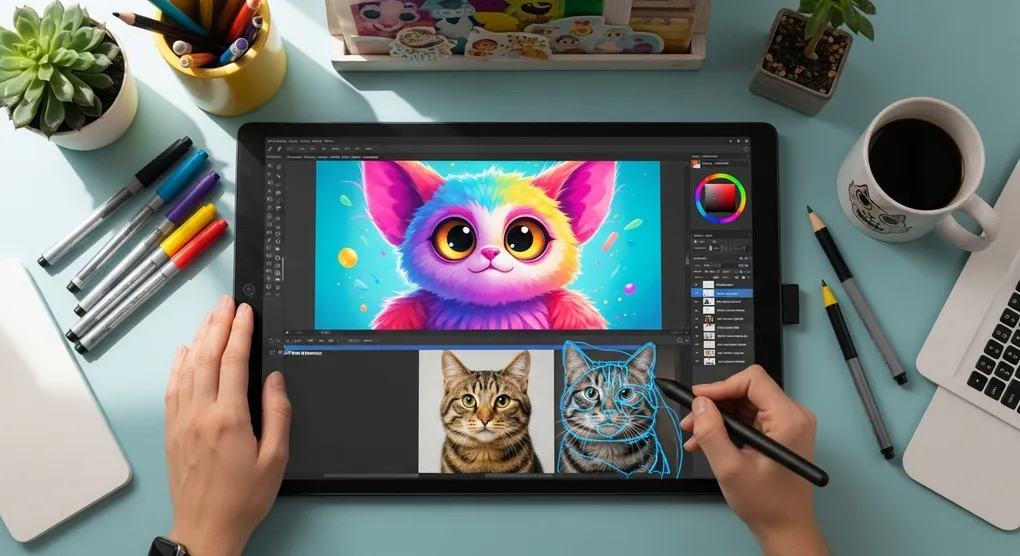
The Great Tracing Debate in Digital Art
Tracing in digital art is the process of drawing over an existing image on a separate layer to replicate its lines and shapes. Many artists dislike it because they see it as a crutch that prevents skill development, a form of plagiarism, and a misrepresentation of one’s actual abilities.
What is Tracing in Digital Art?
Tracing involves placing a source image (like a photograph or another artist’s drawing) into a digital art program, lowering its opacity, and then drawing over it on a new layer above. The final result is a line-for-line copy of the underlying image’s structure. This technique is often used by beginners to practice or by those looking to replicate a specific image precisely [1].
Why Do Some Artists Dislike It?
The strong negative reaction to tracing in the art community, often labeled as “cheating,” is rooted in several core principles.
It Hinders Skill Development
The primary argument against tracing is that it bypasses the development of fundamental art skills. Drawing from observation teaches an artist how to understand and interpret form, perspective, anatomy, and lighting. By simply tracing contours, a person doesn’t learn how to construct a figure or object from scratch, which is a crucial skill for creating original artwork. As one art educator notes, it encourages a “paint-by-numbers” approach rather than fostering true observational and constructional drawing abilities [2].
Concerns Over Plagiarism and Ethics
When an artist traces someone else’s photograph or artwork and passes it off as their own original creation, it is considered plagiarism. This is a serious ethical breach and, in many cases, copyright infringement, especially if the traced work is sold or used for profit. The art community values originality and authorship, and presenting a traced copy as one’s own work is seen as a dishonest act that devalues the effort of the original creator [3].
Lack of Originality and Expression
Art is fundamentally a form of personal expression. Tracing, by its nature, is a reproductive act, not a creative one. While the final rendering might have a different style, the foundational drawing—the composition, pose, and proportions—is borrowed. Critics argue that this leads to derivative work that lacks a unique voice or vision, which is the ultimate goal for most artists [4].
When is Tracing Considered Acceptable?
Despite the stigma, tracing isn’t universally condemned. Its acceptability depends heavily on intent, transparency, and context.
- As a Learning Tool: For absolute beginners, tracing can be a useful exercise to develop hand-eye coordination and muscle memory. It can help someone understand the flow of lines and shapes in a low-pressure way. However, it should be treated as a temporary step, not a final method [2].
- In a Professional Workflow: In commercial art fields like comics or animation, artists sometimes trace over 3D models or rough sketches to speed up their workflow. In this context, tracing is a tool for efficiency, not a substitute for skill. The artist still possesses the underlying knowledge of form and anatomy and is using tracing as a shortcut for a specific, often complex, task [5].
- When Using Your Own Sources: Tracing your own photographs as a reference for a painting or illustration is generally seen as acceptable. The creative work was already done when the photo was composed and taken. Here, tracing is just part of the process of translating that personal reference into a new medium [3].
The key distinction is honesty. If an artist traces, they should be transparent about their process and, if tracing another’s work, must have permission and give proper credit.
References
- [1] Perkins, C. (2022). Is Tracing Cheating? The Great Debate. Procreate Folio.
- [2] Gurney, J. (2010). To Trace or Not to Trace. Gurney Journey Blog.
- [3] Concept Art Empire. (n.d.). Is Tracing Art Cheating? The Definitive Answer.
- [4] Creative Bloq Staff. (2021). Is it OK to trace pictures? Creative Bloq.
- [5] Lunsford, K. (2019). Tracing, Photo-bashing and the Ethics of Reference. Muddy Colors Blog.
Created using Gemini Pro 2.5